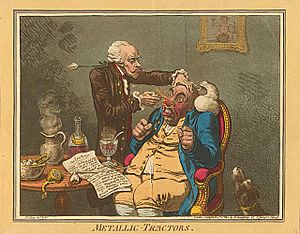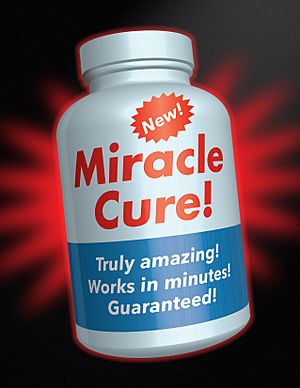Placebo facts for kids

A placebo is like a fake treatment for a sickness or condition. It's made to look like a real medicine or therapy, but it doesn't have any active ingredients. The idea behind using a placebo is that sometimes, if a person believes a treatment will help them, their body might actually start to feel better.
When people who receive a placebo feel better, or their bodies actually improve, it's called the "placebo effect." This term was first used in 1920. It shows how powerful our minds can be in helping our bodies heal. The improvement comes from the person's own belief and expectation, not from the fake medicine itself.
Contents
How We Discovered the Placebo Effect
Scientists have known about the placebo effect for a long time. In the 1700s, a doctor named John Haygarth did a test. He showed that people's "imagination" could have a big effect on their diseases. This meant that just believing something would work could make a difference.
Later, a French pharmacist named Émile Coué worked between 1882 and 1910. He noticed something interesting. He would tell his customers that their medicines were very good and would help them. He even left little positive notes with their medications. He found that his customers often felt better. Coué began to study how people could use their own minds to help themselves. He wrote a book called Self-mastery through conscious autosuggestion. This book explained how thinking positively could help people.
Placebos in Science Experiments
Placebos are very important in science experiments, especially when testing new medicines. These experiments are called "blind trials." Here's how they work:
- Some people get the real medicine or treatment being tested.
- Other people get a placebo, which looks exactly like the real medicine but does nothing.
- No one knows who is getting the real treatment and who is getting the placebo. They are "blind" to their treatment.
This way, scientists can see if the real medicine truly makes a difference. If the group getting the real medicine gets much better than the placebo group, then scientists know the medicine works. If both groups get better by the same amount, it means the improvement might be due to the placebo effect, not the medicine itself. This helps researchers understand if a new treatment is truly effective.
Real Effects of Placebos
Even though placebos don't have active ingredients, they can cause real changes in a person's body. This is what the "placebo effect" means. For some health problems, the placebo effect is very clear. Here are some examples:
- Pain Relief: Many studies show that placebos can help reduce pain. When people expect pain to go away, their brains can actually release natural pain-relieving chemicals.
- Parkinson's Disease: In people with Parkinson's disease, placebos can cause the brain to release dopamine. Dopamine is a chemical that helps control movement.
- Depression: Placebos can help reduce feelings of depression. They can even affect the same parts of the brain that real antidepressant medicines do.
- Caffeine: If someone thinks they are drinking caffeinated coffee (even if it's just decaf), their brain might release more dopamine. This can make them feel more awake.
- Glucose: Just expecting to get an injection of sugar (glucose) can make the brain release dopamine. This has been seen in men.
Related pages
Images for kids
-
A quack treating a patient with Perkins Patent Tractors by James Gillray, 1801. John Haygarth used this remedy to illustrate the power of the placebo effect.
See also
 In Spanish: Sustancia placebo para niños
In Spanish: Sustancia placebo para niños




